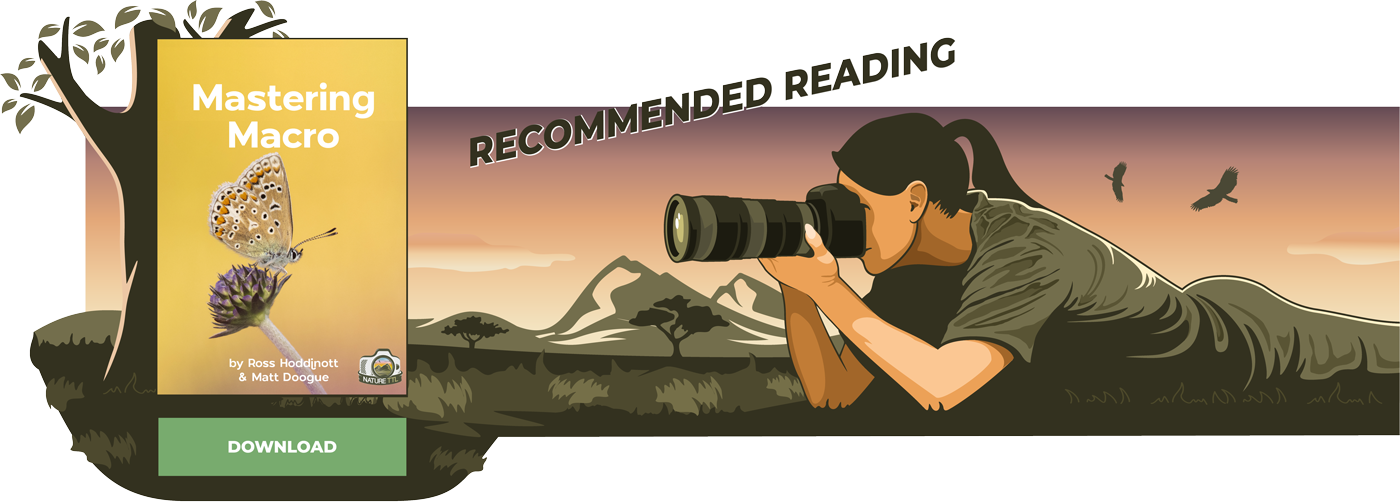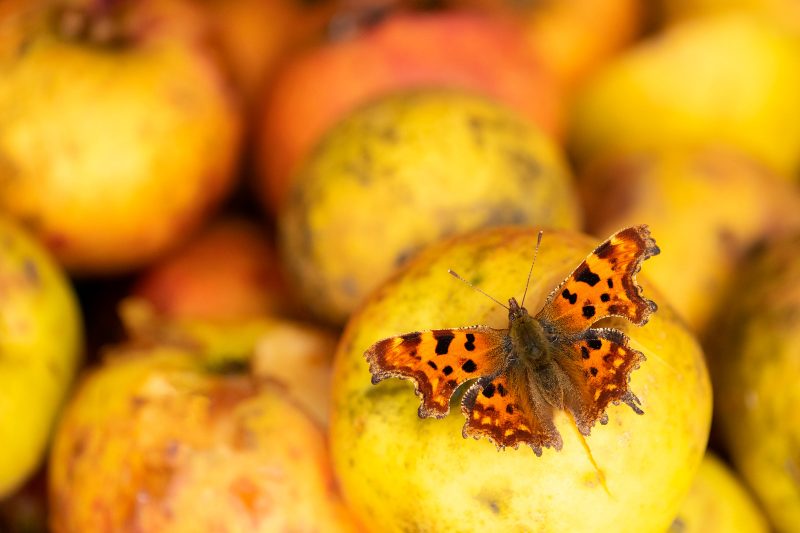The Best Habitats for Macro and Insect Photography

One of the big appeals of macro and close-up photography is that it is so accessible. You don’t need expensive kit to shoot frame-filling shots of little things, and you don’t need to travel far, or spend hours cooped up in a hide, to capture stunning nature shots.
Good macro subjects, such as insects, wildflowers, and fungi, can be found almost anywhere, in any habitat. For this reason, many close-up photographers are opportunists, heading out with their camera and eagle-eyes in the hope of finding interesting miniature subjects to shoot.


However, you can increase your chances of success by learning about what different environments provide, and what they host. Here is a brief overview of some of the best habitats for macro photography.
1. Wetlands
Wetland environments are often excellent for close-up photography. Lakes, lochs, canals, rivers, waterways, ponds, marshes, and bogs are home to stunning flying insects like dragonflies and mayflies, as well as reptiles and wetland plants.
From spring until early autumn, expect to find dragonflies territorially patrolling the water’s edge. If you have a telephoto upwards of 400mm, attempt some flight shots by using your camera’s continuous AF mode and shooting rapid bursts.
Read more on Pond Life Photography for ideas and technique tips.
A fast shutter speed of at least 1/1000sec is recommended, and expect a low ratio of success, as dragonflies are fast, unpredictable, and can fly in any direction. They will often have a preferred branch or reed where they like to return to rest, though.
Observe their behaviour and, once you’ve identified a regular perch, stand close by with your camera set-up, ready for when they next return.
Insects are least active in the early morning and late evening, so visit wetlands at these times and carefully search grasses and reeds close to the water’s edge. Expect to find roosting damselflies and mayflies, among other insects. While they are cool, there is less risk they will fly or scurry away when you approach them with your camera.
You may even be able to set up a tripod, which will aid precise focusing and framing. During late winter, frogs and toads will return to ponds to breed. This is a great opportunity to get good shots. Kneel or lay by the water’s edge and wait for them to pop their heads above the water’s surface to breathe.
A low viewpoint will look intimate and allow you to shoot the subject together with their reflection. In damp and boggy margins, look for wetland flowers like marsh orchids, yellow flag iris, bogbean, marsh marigolds, cotton grass, and maybe even carnivorous sundew.
You may also spot raft spiders, colourful snails, and other interesting miniature creatures. This really is a rich habitat for close-up photography. You just need to look closely and be patient.
2. Meadows
Take a stroll through a grassy meadow during summer and you should discover a huge number of potential subjects. Wild orchids, knapweed, oxeye daisies, yellow rattle, clover, meadow thistles, scabious, and a variety of tall, swaying grasses will not only provide picture potential of their own, but also a rich environment for a huge number of invertebrates.
It is estimated that five acres of grassland contain one ton of insects, while one acre of hay meadow can contain over 2 million spiders alone!
Unimproved grassland, free of the use of pesticides, will be home to ladybirds, beetles, dock bugs, crag spiders, bees, hoverflies, and hungry caterpillars. As always, some insects are more obvious than others.
Be prepared to get down low and carefully scan flowers and grasses for subjects, or stay close to nectar rich meadow flowers and wait for subjects to visit in order to feed. From time to time, simply stand still and listen – the chirp of a grasshopper or cricket will betray their whereabouts.
Uncultivated hay meadows may be home to clouds of butterflies, including meadow browns, marbled whites, skippers, common blues, and day flying moths – you shouldn’t be short of potential subjects.
Again, morning and evening are typically the best times for close-up photography. Insects are colder and less active and, while this might make them harder to find, it also makes them easier to photograph. In the morning, after a clear, cool night, expect insects to be dew-covered and glistening in the warm, early sunlight.
Tiny droplets of dew will provide scale and interest to your close-ups and, together with the light’s quality, make the early wake-up time worthwhile. But, be careful of where you tread when looking for subjects: roosting insects are highly vulnerable to careless feet. When setting up your tripod, be careful not to knock or disturb subjects, and generally always place your subject’s welfare first.
Watch our YouTube video on How to Photograph Butterflies and Insects.
3. Heathland and moorland
This is yet another rich habitat for plant-life, invertebrates, and reptiles too. Heaths are large open spaces where gorse, bracken, and heather often thrive. This is one of our most threatened wildlife habitats. If you have an area of heathland or moorland close to where you live, this is definitely a habitat worth exploring with your camera and a close focusing lens.
Late summer is a particularly good time to visit, when heaths and moors can be carpeted in flowering bell heather, ling, and gorse, which not only attract insects, but can provide a beautiful and colourful backdrop too.
Look for butterflies, such as silver-studded blues, grayling, small coppers, and gatekeepers, along with emperor moths, wasp spiders, heath grasshoppers, bush crickets, and green tiger beetles. Heaths and moors are often home to small ponds where dragonflies and damselflies will thrive.
The UK is home to six species of reptile, and they can all be found on heaths. Generally speaking, reptiles are quite challenging to get close to and photograph, being hugely sensitive to movement and noise, and often scurrying away before you can get within picture-taking range.
Look for lizards basking on logs or wooden posts, or among rocks or dry leaves. Snakes will bask on paths or in clearings. A longer focal length will allow you to shoot from further away and reduce the risk of disturbing your subject. It is also recommended that photographers keep a responsible distance away from venomous snakes, like adders.
A telephoto upwards of 300mm, or a tele-macro lens, would be best tool for the job. A low eye-to-eye viewpoint will normally produce the most natural and intimate image.
Close-up photographers are often crawling through vegetation, or kneeling or laying down on the ground in order to take photos. This makes them prone to picking up ticks, which can carry Lyme disease.
To help prevent bites, wear light-coloured, protective clothing, and keep trouser legs tucked in. Consider wearing a suitable repellent, and check your skin regularly. Carry a tick removal tool in your camera bag and if you display any flu-like symptoms after being bitten, visit your doctor immediately.
4. Woodland
None of us live far from an area of woodland or trees, and this is an environment alive with miniature subjects. In spring, ancient deciduous woodland will be carpeted with wildflowers, including lesser celandine, wood anemone, sorrel, bluebells, and wild garlic: all of which look stunning in close-up.
The shade of the trees provides even, low-contrast light that is suited to recording exquisite miniature detail and natural, saturated colours.
Carry a small reflector with you in order to bounce a little extra light onto flower stems, and relieve ugly shadow areas. Woodland rides and glades – corridors of open space between trees – are great places to look for insects.
These areas are warm and sheltered and are enjoyed by a host of woodland butterflies, like silver-washed fritillaries, white admirals, hairstreaks, and speckled woods.
You may also see hawker dragonflies hunting, and darters perched on low branches. Beetles, ants, snails, scorpion flies, hornets, and shield bugs are among the minibeasts you might find and photograph, while wooded streams may be home to beautiful demoiselles and caddisflies.
When stalking subjects with a handheld camera, avoid sudden movements, and select a sufficiently fast shutter speed to avoid both camera and subject motion. Increase ISO sensitivity if required. Look for subjects that you can photograph against a clean background, and avoid including messy vegetation that will dominate the frame.
Although there are normally fewer insects around to photograph once autumn arrives, woodland provides an abundance of curious-looking fungi to photograph. Look among leaf litter, and on fallen and decaying tree trunks, stumps, and branches, for subjects.
Read How to Photograph Fungi for tips and techniques.
5. The coast
The beach might seem like a less obvious habitat for macro subjects, but the low tide will reveal plenty of picture potential. Using a macro lens or close-up attachment, take a closer look at seaweed, barnacles, limpets, mussels, anemones, and crabs.
Also look for interesting and abstract-looking patterns and texture in rocks and ledges.
Apolarising filter can be useful for coastal close-ups, helping eliminate distracting glare and reflections. Sand dunes and salt marshes are often home to a wealth of coastal plants, insects, and reptiles. Sea campion, pyramidal orchids, thrift, sea holly, golden samphire, and sea aster are among the wildflowers you might find and photograph along the coast.
A good variety of butterflies and moths will inhabit coastal areas too, including silver-studded blues and fritillaries, and cinnabar and burnet moths. Glow worms, tiger beetles, and snails are other subjects you might find. Reptiles, like adders and sand lizards, also love basking among the dunes.
Read How to Take Coastal Close-up Macro Photos for tips and ideas.
6. Gardens
Of course, you don’t have to travel any further than your own back garden to capture great close-ups. Today, our gardens are a rich and important habitat for a huge variety of creatures.
Try to manage your garden with wildlife in mind. For example, plant nectar-rich plants, and avoid being too tidy – insects love long grasses, weeds, and piles of leaves, logs, or branches. Explore every corner of your garden closely – look under leaves, plant pots, and around garden ponds for potential subjects.
In late summer, fruit bushes and windfall apples will entice butterflies and wasps. I shoot a huge number of my close-up images at home.
For advice, read A Guide to Garden Macro Photography.
In conclusion
Quite simply, wherever you go, great macro opportunities are just waiting to be discovered. So, what is stopping you? Grab your close-up kit and start exploring!
For more depth techniques and advice for getting into wildlife photography, take a look at our So You Want to be a Wildlife Photographer ebook.






















